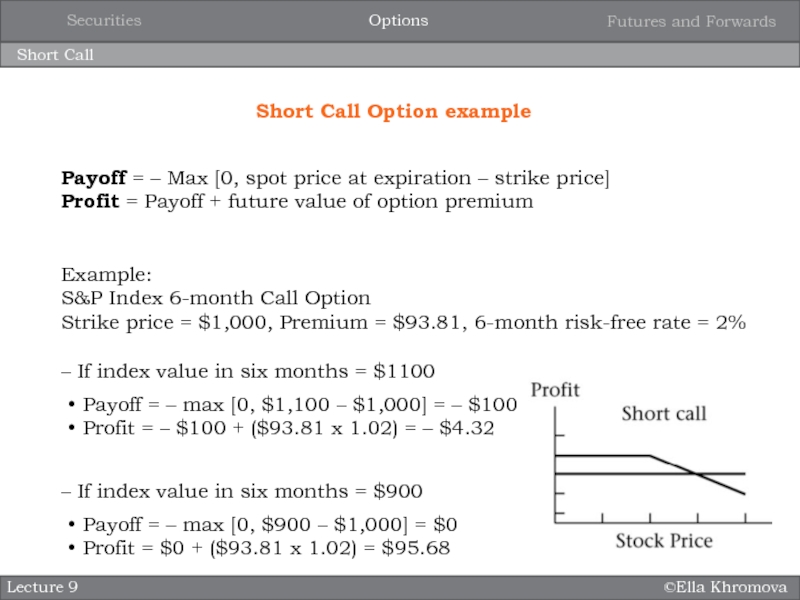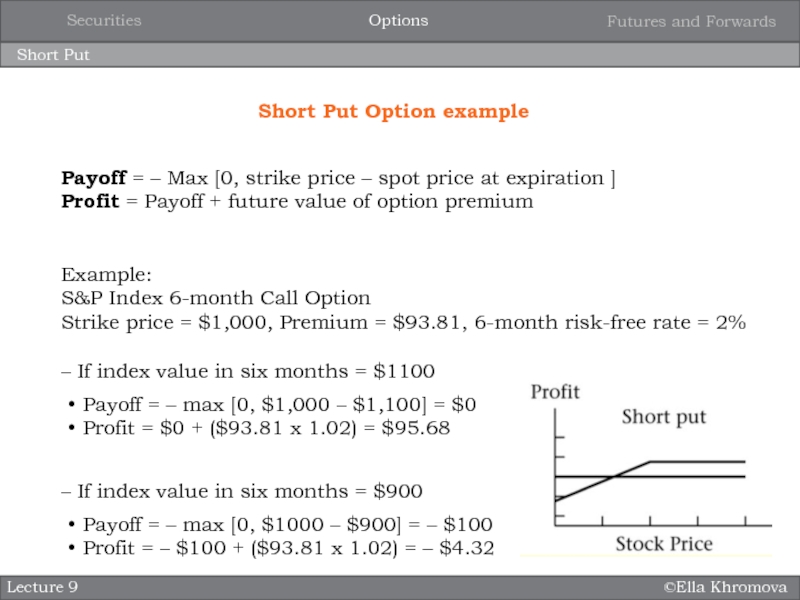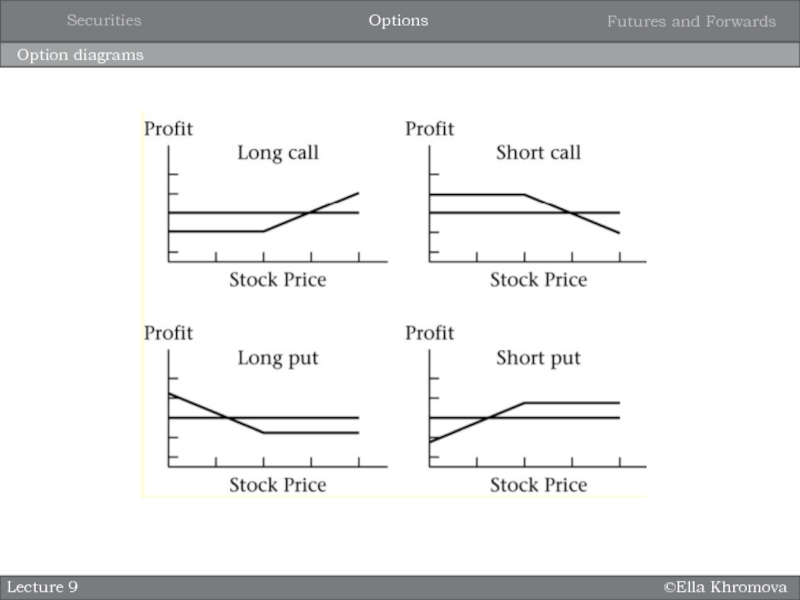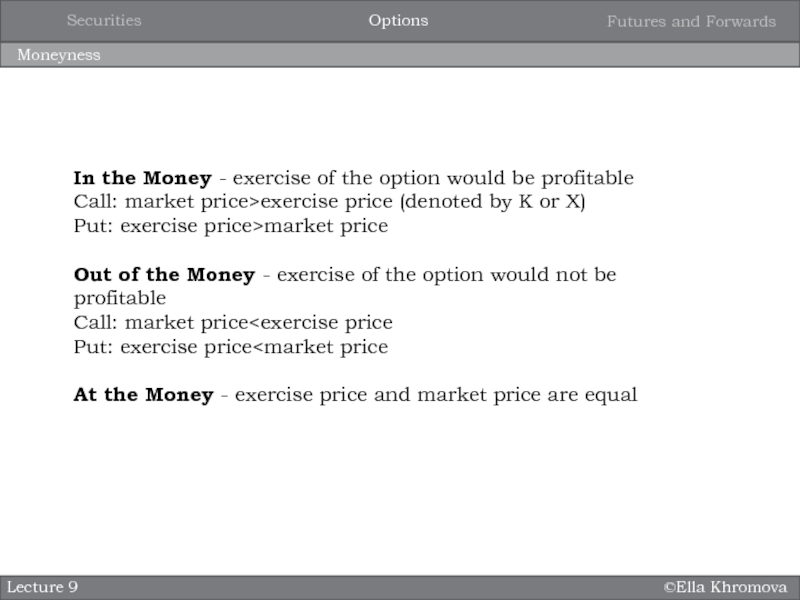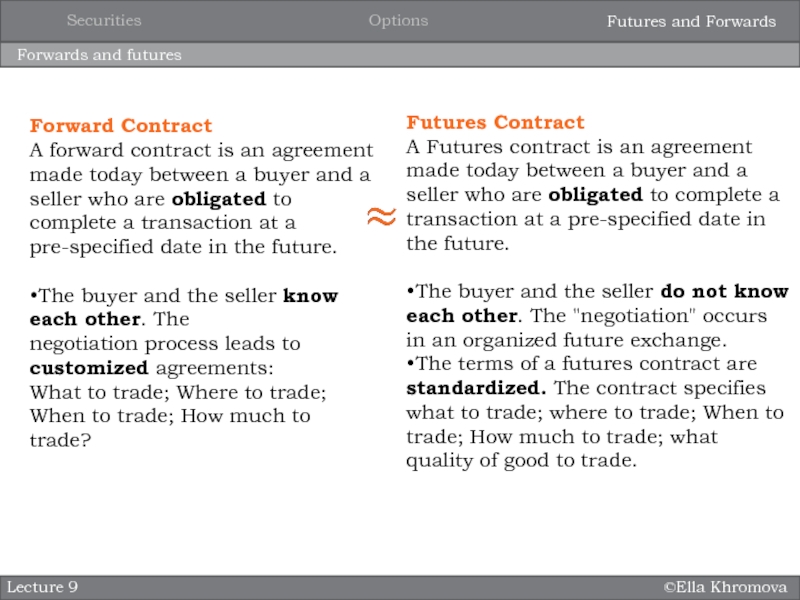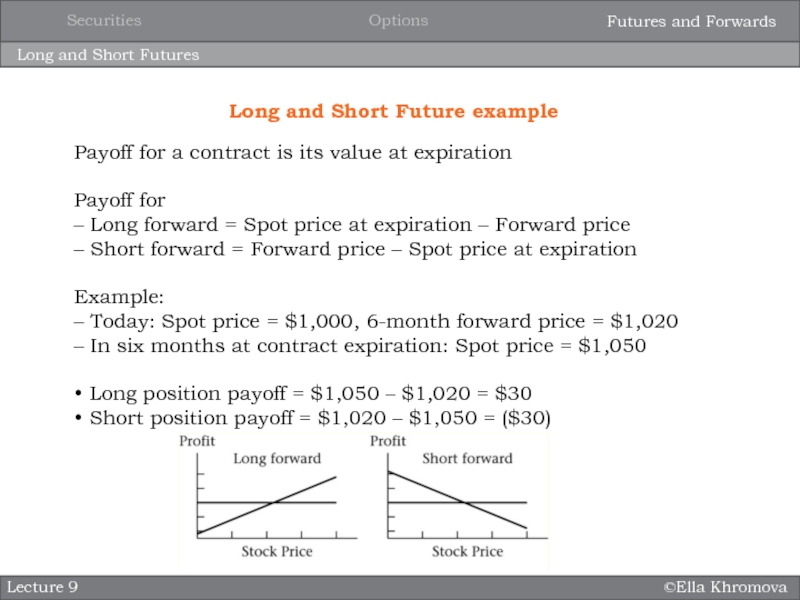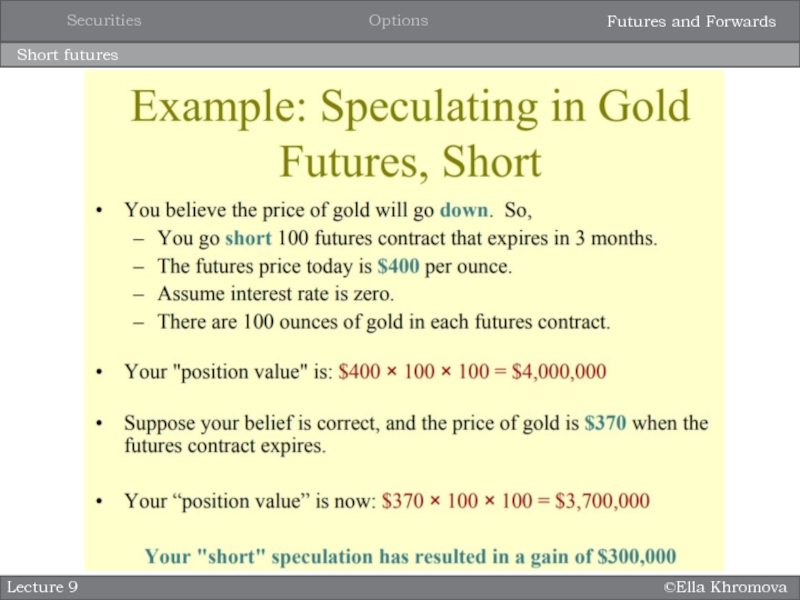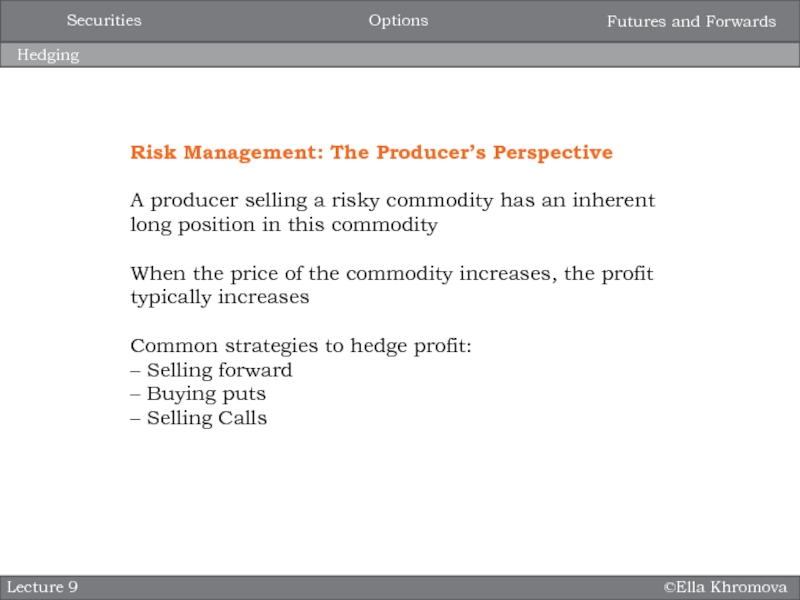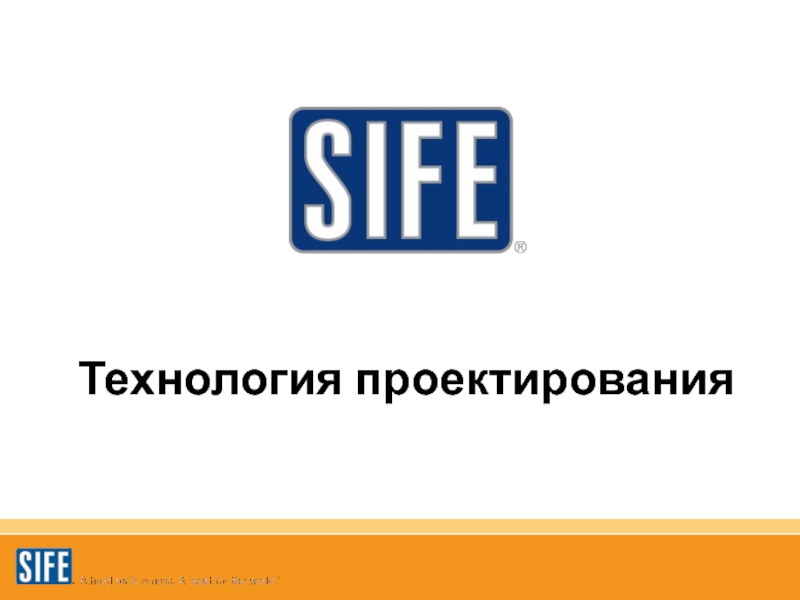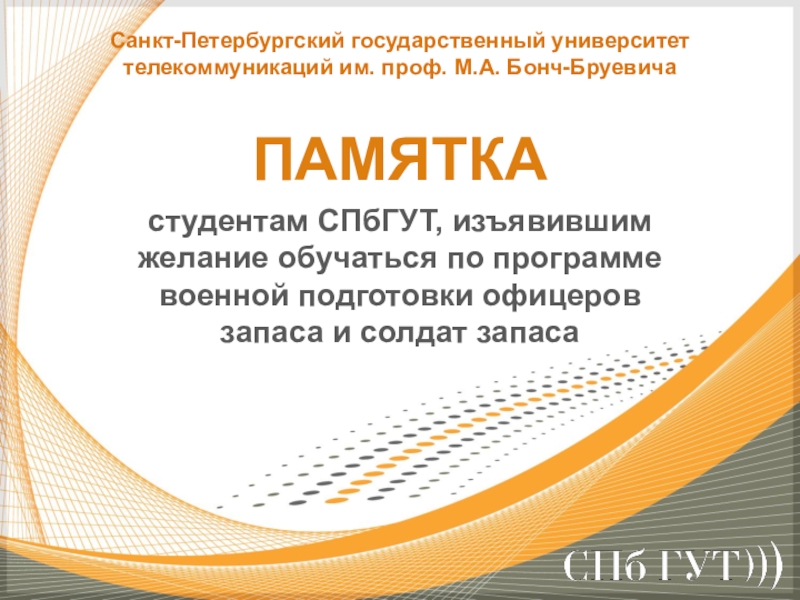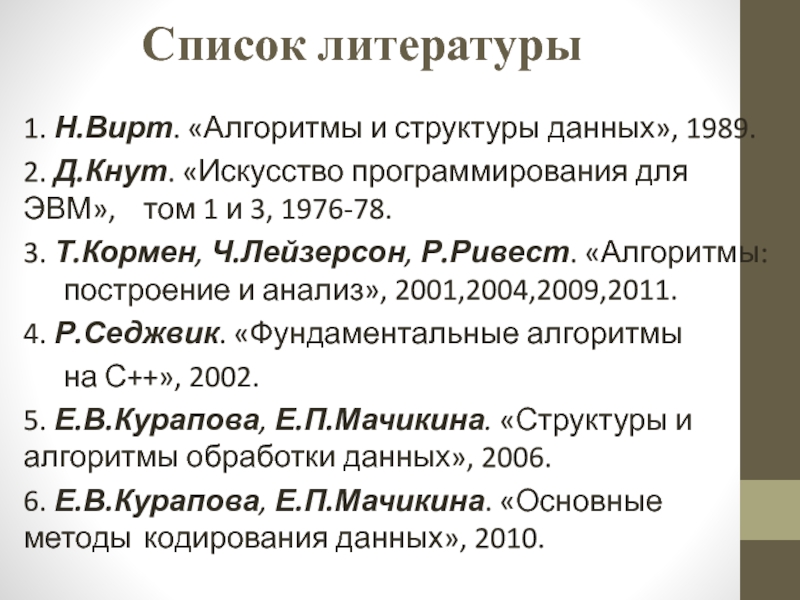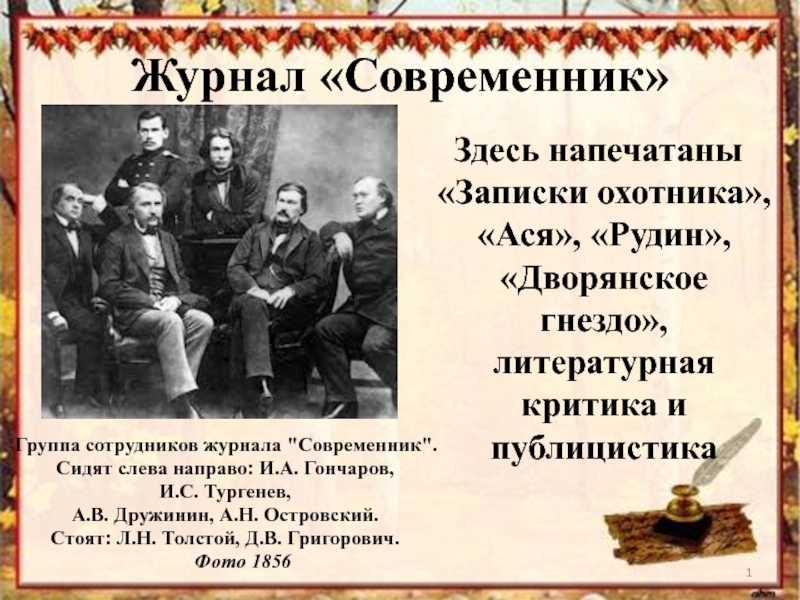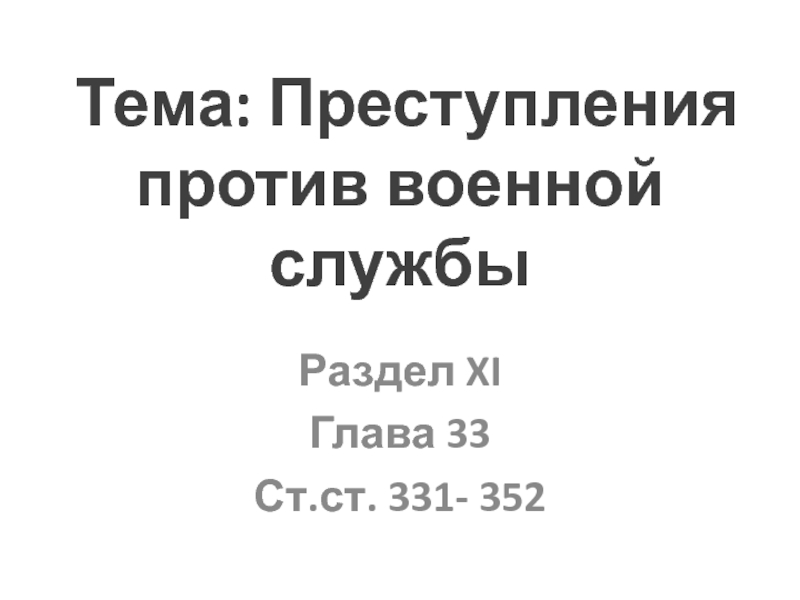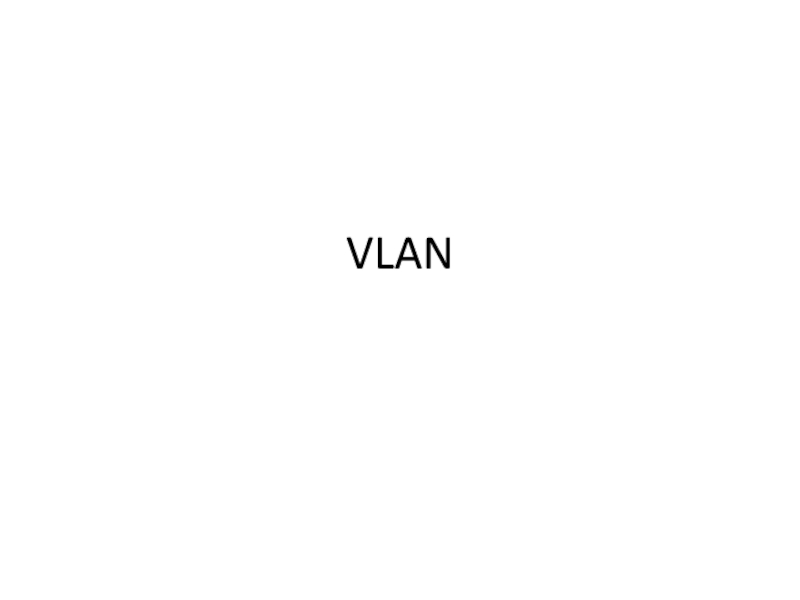Разделы презентаций
- Разное
- Английский язык
- Астрономия
- Алгебра
- Биология
- География
- Геометрия
- Детские презентации
- Информатика
- История
- Литература
- Математика
- Медицина
- Менеджмент
- Музыка
- МХК
- Немецкий язык
- ОБЖ
- Обществознание
- Окружающий мир
- Педагогика
- Русский язык
- Технология
- Физика
- Философия
- Химия
- Шаблоны, картинки для презентаций
- Экология
- Экономика
- Юриспруденция
Project comments
Содержание
- 1. Project comments
- 2. ©Ella KhromovaBonds and Stocks market evaluationProjectBondsExpected returnRiskYTM
- 3. ©Ella KhromovaEquity estimationStocksBondsClient ProfileTarget-settingProject
- 4. ©Ella KhromovaRelative Valuation: Most Commonly used MultiplesLecture
- 5. ©Ella KhromovaRelative Valuation: Step by step procedureLecture 7EquityFinancial Instruments
- 6. ©Ella KhromovaPortfolio calculationProjectComment on diversification of your
- 7. Lecture 9. Financial markets: Derivatives©Ella KhromovaLecture 9International finance and globalizationOptionsSecuritiesFutures and Forwards
- 8. ©Ella KhromovaWhat are Derivatives?Lecture 9Primary assetsSecurities sold
- 9. ©Ella KhromovaOptionsLecture 9Options:• Call - option to
- 10. ©Ella KhromovaLong CallLecture 9Long Call Option examplePayoff
- 11. ©Ella KhromovaShort CallLecture 9Short Call Option examplePayoff
- 12. ©Ella KhromovaLong PutLecture 9Long Put Option examplePayoff
- 13. ©Ella KhromovaShort PutLecture 9Short Put Option examplePayoff
- 14. ©Ella KhromovaOption diagramsLecture 9OptionsSecuritiesFutures and Forwards
- 15. ©Ella KhromovaMoneynessLecture 9In the Money - exercise
- 16. ©Ella KhromovaForwards and futuresLecture 9Forward ContractA forward
- 17. ©Ella KhromovaLong and Short FuturesLecture 9Long and
- 18. ©Ella KhromovaLong FuturesLecture 9OptionsSecuritiesFutures and Forwards
- 19. ©Ella KhromovaShort futuresLecture 9OptionsSecuritiesFutures and Forwards
- 20. ©Ella KhromovaHedgingLecture 9Risk Management: The Producer’s Perspective
- 21. Скачать презентанцию
Слайды и текст этой презентации
Слайд 1Project comments
©Ella Khromova
Project
International finance and globalization
Stock evaluation
Expected return and risk
Portfolio
calculation
Слайд 2©Ella Khromova
Bonds and Stocks market evaluation
Project
Bonds
Expected return
Risk
YTM (%)
Capital gain (%)
DUR
(M.DUR -%)
Price volatility (%)
Hold until maturity
Sell before maturity
Stocks
Expected return
Risk
Dividend yield
(%)Capital gain (YearToDate%)
Price volatility (%)
Passive investment
Speculation
In order to forecast price direction compare Multiples of a company vs industry
Stock evaluation
Expected return and risk
Portfolio calculation
= Annual coupon(%) + Capital gain(%) =
= Annual coupon(%) + ((Pnew-Pold)/Pold *100)/#of years hold
Expected annual return of a bond (if you sell before maturity)(%)
Expected annual return of a stock(%)
= Dividend yield(%) + Capital gain(%) =
= Dividend yield(%) + ((Pnew-Pold)/Pold *100)/#of years hold
Слайд 4©Ella Khromova
Relative Valuation: Most Commonly used Multiples
Lecture 7
Multiples
Attributable to all
stakeholders: debtors and shareholders
(based on enterprise value)
Attributable to shareholders only
(based
on equity value)EV/Sales
EV/EBITDA
P/E=Price to Earnings= (Equity Value aka Market Capitalization / Net Income)
Equity
Financial Instruments
Слайд 6©Ella Khromova
Portfolio calculation
Project
Comment on diversification of your portfolio!
Expected return of
a portfolio
Stock evaluation
Expected return and risk
Portfolio calculation
You can assume
during your calculations that Covariance between any securities is zero . However you need separately to comment whether your securities are correlated or not and whether it is good or bad in terms of your portfolio riskСлайд 7Lecture 9.
Financial markets: Derivatives
©Ella Khromova
Lecture 9
International finance and globalization
Options
Securities
Futures
and Forwards
Слайд 8©Ella Khromova
What are Derivatives?
Lecture 9
Primary assets
Securities sold by firms or
government to raise capital (stocks and bonds) as well as
stock indexes (S&P, Nikkei), interest rates, exchange rates, credit risk, commodities (gold, coffee, corn)…Derivatives assets
Options, forward and futures contracts, FRAs, Eurodollars, Swaption, CDS, etc. These financial assets are derived from existing primary assets
Securities
Exchange-traded
Over-the-counter traded
Why using derivatives?
– Risk management (e.g., hedging)
– Speculation
– Reduce market frictions, e.g., cost of default, taxes, and transaction costs
– Exploit arbitrage opportunities
Exchange-traded
Over-the-counter traded
Options
Securities
Futures and Forwards
Слайд 9©Ella Khromova
Options
Lecture 9
Options:
• Call - option to buy underlying asset
• Put - option to sell underlying asset
A call/put option
gives the owner the right but not the obligation to buy/sell the underlying asset at a predetermined price during a predetermined time period.• Strike (or exercise) price: the amount paid by the option buyer for the
asset if he/she decides to exercise
• Exercise: the act of paying the strike price to buy the asset
• Expiration: the date by which the option must be exercised or become
Worthless
Premium: the price of the option paid today
• Exercise style: specifies when the option can be exercised
– European-style: can be exercised only at expiration date
– American-style: can be exercised at any time before expiration
– Bermudan-style: can be exercised during specified periods (e.g., on the first day of each month. Bermuda is located between the US and Europe.)
Options
Securities
Futures and Forwards
Слайд 10©Ella Khromova
Long Call
Lecture 9
Long Call Option example
Payoff = Max [0,
spot price at expiration – strike price]
Profit = Payoff –
future value of option premiumExample:
S&P Index 6-month Call Option
Strike price = $1,000, Premium = $93.81, 6-month risk-free rate = 2%
– If index value in six months = $1100
– If index value in six months = $900
• Payoff = max [0, $1,100 – $1,000] = $100
• Profit = $100 – ($93.81 x 1.02) = $4.32
• Payoff = max [0, $900 – $1,000] = $0
• Profit = $0 – ($93.81 x 1.02) = – $95.68
Options
Securities
Futures and Forwards
Слайд 11©Ella Khromova
Short Call
Lecture 9
Short Call Option example
Payoff = – Max
[0, spot price at expiration – strike price]
Profit = Payoff
+ future value of option premiumExample:
S&P Index 6-month Call Option
Strike price = $1,000, Premium = $93.81, 6-month risk-free rate = 2%
– If index value in six months = $1100
– If index value in six months = $900
• Payoff = – max [0, $1,100 – $1,000] = – $100
• Profit = – $100 + ($93.81 x 1.02) = – $4.32
• Payoff = – max [0, $900 – $1,000] = $0
• Profit = $0 + ($93.81 x 1.02) = $95.68
Options
Securities
Futures and Forwards
Слайд 12©Ella Khromova
Long Put
Lecture 9
Long Put Option example
Payoff = Max [0,
strike price – spot price at expiration ]
Profit = Payoff
– future value of option premiumExample:
S&P Index 6-month Call Option
Strike price = $1,000, Premium = $93.81, 6-month risk-free rate = 2%
– If index value in six months = $1100
– If index value in six months = $900
• Payoff = max [0, $1,000 – $1,100] = $0
• Profit = $0 – ($93.81 x 1.02) = – $95.68
• Payoff = max [0, $1000 – $900] = $100
• Profit = $100 – ($93.81 x 1.02) = $4.32
Options
Securities
Futures and Forwards
Слайд 13©Ella Khromova
Short Put
Lecture 9
Short Put Option example
Payoff = – Max
[0, strike price – spot price at expiration ]
Profit =
Payoff + future value of option premiumExample:
S&P Index 6-month Call Option
Strike price = $1,000, Premium = $93.81, 6-month risk-free rate = 2%
– If index value in six months = $1100
– If index value in six months = $900
• Payoff = – max [0, $1,000 – $1,100] = $0
• Profit = $0 + ($93.81 x 1.02) = $95.68
• Payoff = – max [0, $1000 – $900] = – $100
• Profit = – $100 + ($93.81 x 1.02) = – $4.32
Options
Securities
Futures and Forwards
Слайд 15©Ella Khromova
Moneyness
Lecture 9
In the Money - exercise of the option
would be profitable
Call: market price>exercise price (denoted by K
or X) Put: exercise price>market price
Out of the Money - exercise of the option would not be profitable
Call: market price
At the Money - exercise price and market price are equal
Options
Securities
Futures and Forwards
Слайд 16©Ella Khromova
Forwards and futures
Lecture 9
Forward Contract
A forward contract is an
agreement made today between a buyer and a seller who
are obligated to complete a transaction at a pre-specified date in the future.•The buyer and the seller know each other. The
negotiation process leads to customized agreements:
What to trade; Where to trade; When to trade; How much to trade?
Futures Contract
A Futures contract is an agreement made today between a buyer and a seller who are obligated to complete a
transaction at a pre-specified date in the future.
•The buyer and the seller do not know each other. The "negotiation" occurs in an organized future exchange.
•The terms of a futures contract are standardized. The contract specifies what to trade; where to trade; When to
trade; How much to trade; what quality of good to trade.
Options
Securities
Futures and Forwards
Слайд 17©Ella Khromova
Long and Short Futures
Lecture 9
Long and Short Future example
Payoff
for a contract is its value at expiration
Payoff for
– Long
forward = Spot price at expiration – Forward price– Short forward = Forward price – Spot price at expiration
Example:
– Today: Spot price = $1,000, 6-month forward price = $1,020
– In six months at contract expiration: Spot price = $1,050
• Long position payoff = $1,050 – $1,020 = $30
• Short position payoff = $1,020 – $1,050 = ($30)
Options
Securities
Futures and Forwards
Слайд 20©Ella Khromova
Hedging
Lecture 9
Risk Management: The Producer’s Perspective
A producer selling
a risky commodity has an inherent long position in this
commodityWhen the price of the commodity increases, the profit typically increases
Common strategies to hedge profit:
– Selling forward
– Buying puts
– Selling Calls
Options
Securities
Futures and Forwards
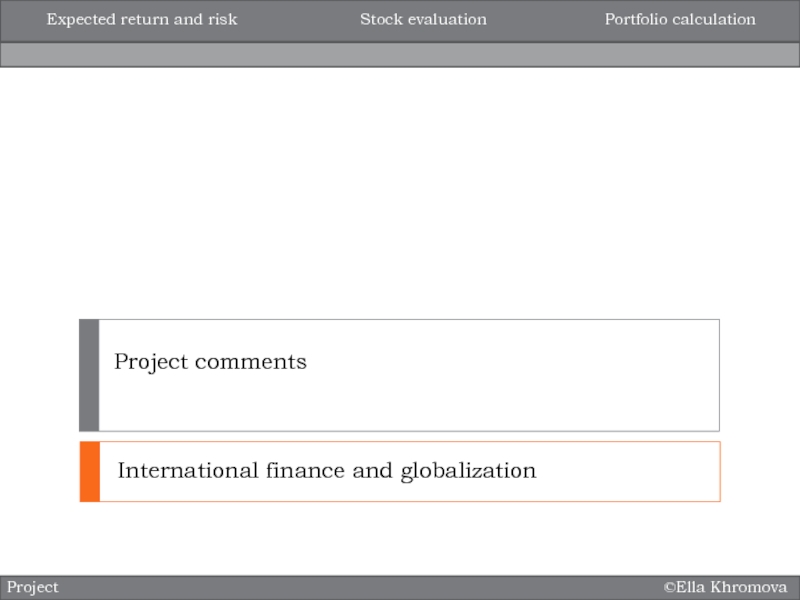
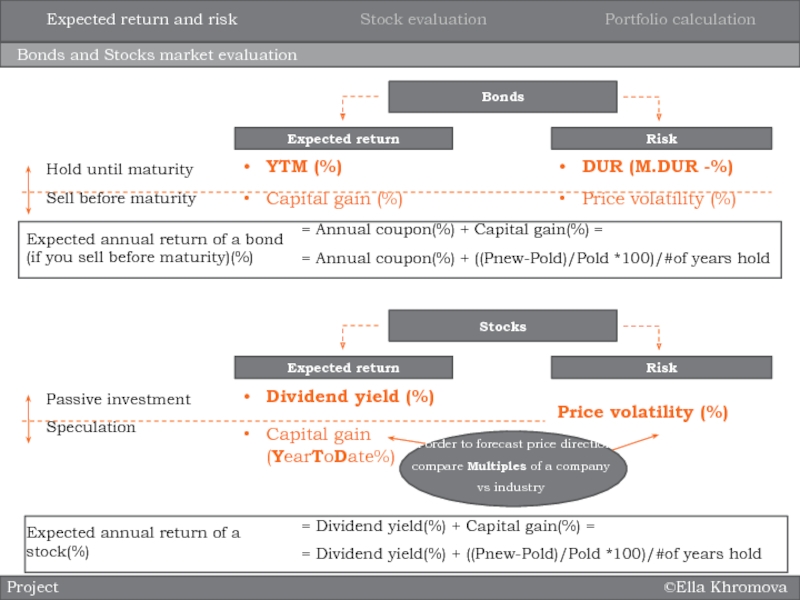
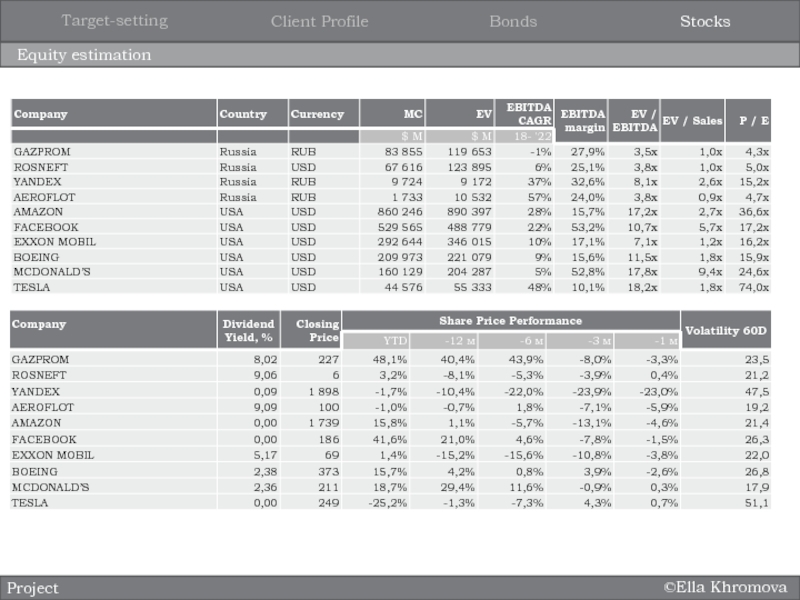
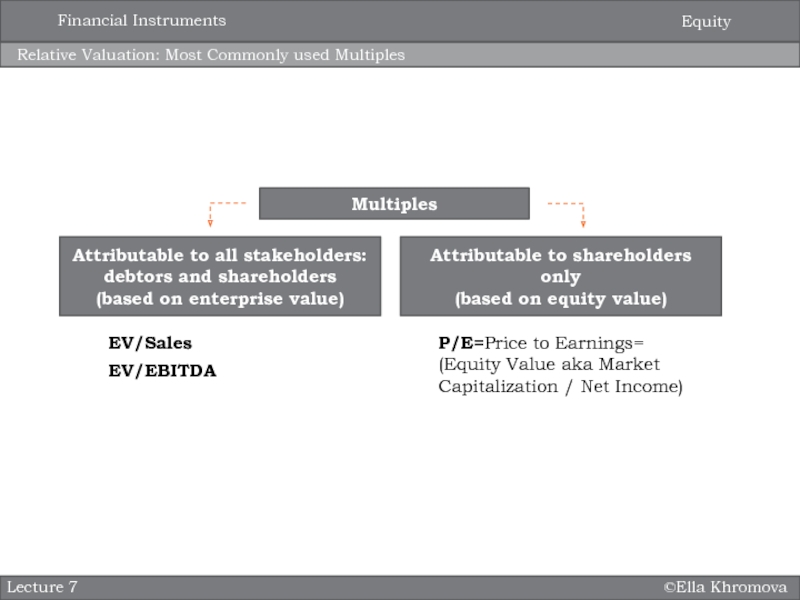

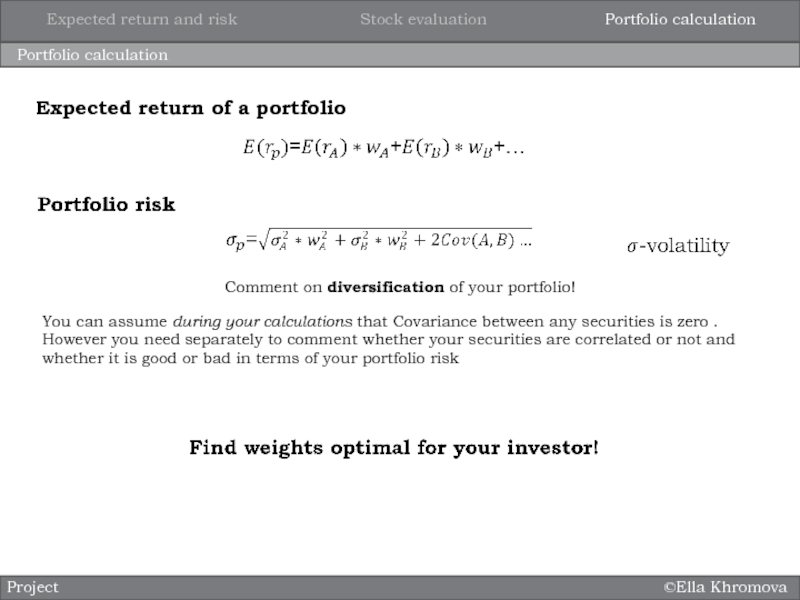
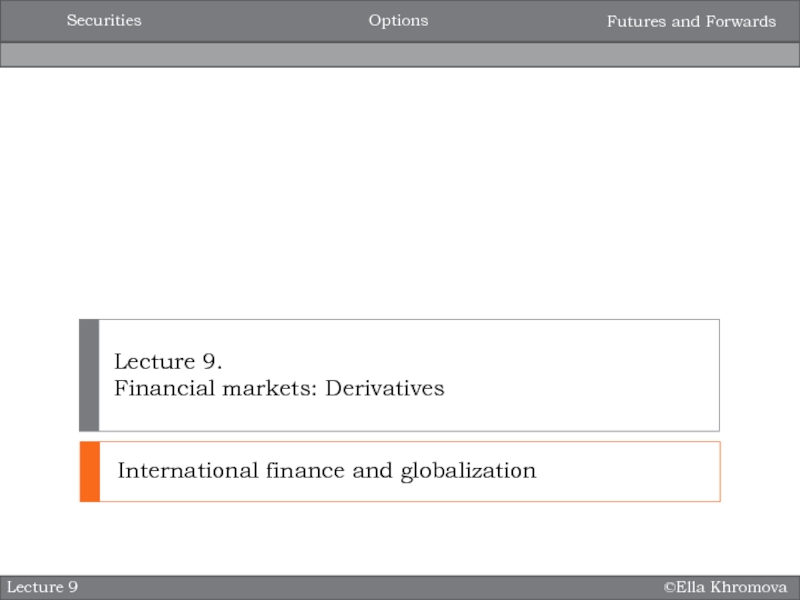
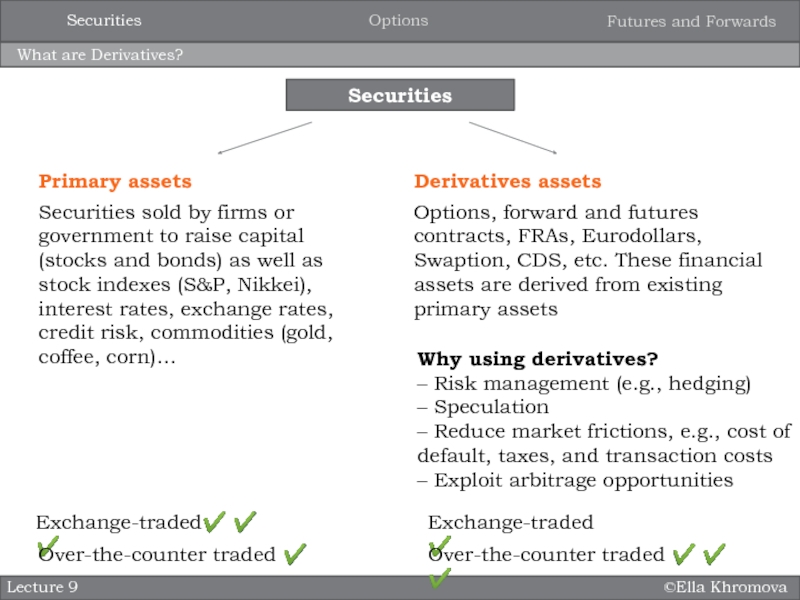
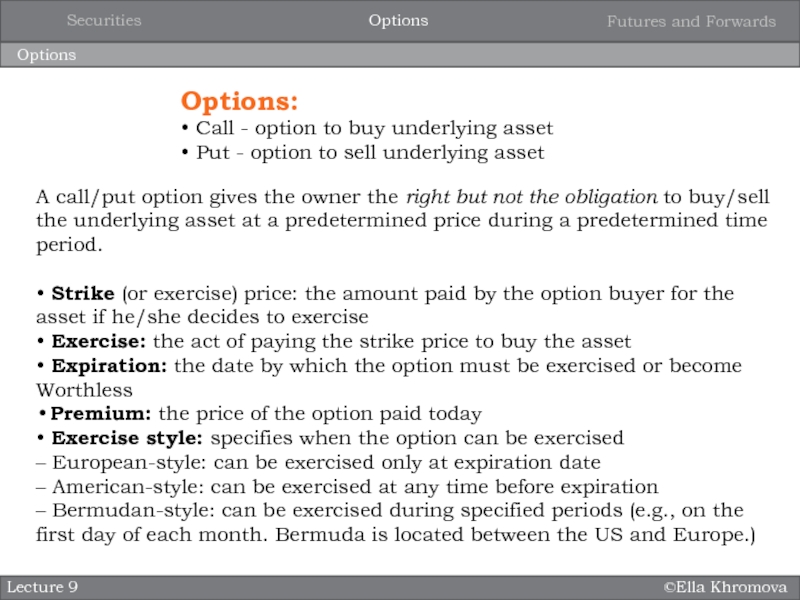
![Project comments ©Ella KhromovaLong CallLecture 9Long Call Option examplePayoff = Max [0, spot ©Ella KhromovaLong CallLecture 9Long Call Option examplePayoff = Max [0, spot price at expiration – strike price]Profit](/img/thumbs/44e84dce16123e036877ae75ac3106e0-800x.jpg)
